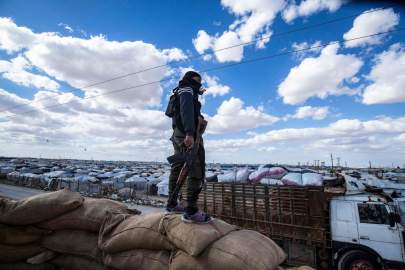Russia Strikes Islamic State Strongholds in Syria as Insurgency Gains Ground

Russia unleashed airstrikes that it said killed as many as 200 militants in central Syria amid an intensifying assault by Islamic State insurgents that threatens the Syrian government’s access to oil and heightens the risks for its foreign backers.
The airstrikes on a training camp took place Monday in Palmyra, according to Alexander Karpov, deputy chief of the Russian Center for Reconciliation of the Opposing Parties in Syria, a military entity. Islamic State militants are known to operate in the area.
The Syrian Observatory for Human Rights, which monitors developments in the Syrian war, said 26 Islamic State members died in Russian airstrikes in Palmyra and other areas of the central Syrian desert in recent days.
Islamic State in 2015 captured the ruins of the ancient city of Palmyra and destroyed a series of Roman temples, tombs and other objects. Backed by Russian airstrikes, the Syrian government retook the ruins in 2016.
The airstrikes came after Islamic State claimed to have killed two Russian soldiers who attempted to land in a helicopter in Syria’s Homs province.
From hide-outs in the desert in central and eastern Syria, Islamic State militants over the past year have extended their reach, striking major highways across the country, attacking oil convoys, assassinating Syrian military commanders and killing a Russian major general in a roadside bombing in April 2020.
Though they no longer control significant territory two years after losing a self-proclaimed caliphate, the militants are accelerating the tempo of their attacks, leaving President Bashar al-Assad to battle an insurgency in parts of the country he nominally rules.
“You can contain it but you can’t destroy it,” said Robert Ford, a former U.S. ambassador to Syria, referring to Islamic State.
The rising violence poses problems for Russia and Iran. The two foreign powers helped Mr. Assad reclaim much of the country and are critical to efforts to reimpose government control in remote parts of central and eastern Syria.
Meanwhile, Iran-backed factions are fortifying bases in the desert on the Syrian-Iraqi border in an effort to curb Islamic State attacks and secure their influence in the region. The bases have so far proven ineffective, says Manhal Bareesh, a Syrian researcher, since Islamic State is able to strike Iran-backed factions even inside the relative safety of major towns and cities.
The insurgency also adds pressure on the Biden administration as it considers the future of the U.S. presence in Syria, which includes hundreds of American troops working with local militias to combat Islamic State in a section of eastern Syria north of the Euphrates river.
Operations by the U.S.-backed Syrian Democratic Forces have flushed out groups of Islamic State fighters and commanders from northeastern Syria, only to have the militants find refuge in government-held territory south of the Euphrates, according to Omar Abu Layla, a Syrian expert on the conflict and the head of a news outlet in Deir Ezzour, the largest city in the country’s east.
After Islamic State captured a swath of territory in Iraq and Syria in 2014, its territorial empire collapsed under an assault by Iraqi and Syrian forces backed by thousands of U.S. airstrikes and a parallel military effort organized by Iran. In 2019, the extremist group lost its last territorial foothold in northeastern Syria.
Counterterrorism officials and experts expected the group to return to its earlier condition as a grass-roots militant organization that formed during the insurgency against the U.S. invasion of Iraq in 2003. The intensity of the group’s resurgence has surprised many who have tracked the group’s evolution.
In 2020, Islamic State carried out at least 286 attacks within Syria, more than double the number of the previous year, and killed at least 432 pro-government fighters and 41 civilians, according to a detailed count of the attacks by Gregory Waters, a researcher at the Middle East Institute and a specialist on the extremists’ Syrian insurgency. Since January 2021, the group’s attacks have killed at least 189 people including civilians, according to Mr. Waters.
Operations by Syrian and Russian forces to retake the militants’ strongholds have collapsed against more formidable opposition. In one operation last year Syrian government troops and Russian military contractors attempted to clear Islamic State from an oasis in central Syria after a series of attacks on a nearby town. Overwhelmed by Islamic State fighters in the area, the pro-government forces were forced to retreat, according to Syrian monitors and Mr. Waters.
Islamic State’s attacks on oil facilities and convoys transporting oil have created widespread discontent with the regime in Damascus. Mr. Assad and his allies have failed to provide adequate services to the areas they have recaptured from Islamic State, according to Saddam al-Jassir, a researcher from eastern Syria.
“Daesh is an idea,” he said, using the Arab acronym for Islamic State. “It never went away and it’s still there because there has not been an idea to take its place.”
Photo: A Kurdish-run camp in northeastern Syria that holds suspected relatives of Islamic State fighters, shown last month.
PHOTO: DELIL SOULEIMAN/AGENCE FRANCE-PRESSE/GETTY IMAGES
Link:




